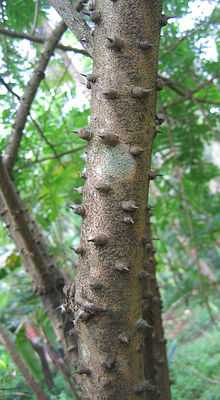Caesalpinia sappan
| Caesalpinia sappan | |
|---|---|
 | |
| Leaves and fruits of Caesalpinia sappan | |
| Conservation status | |
| Scientific classification | |
| Kingdom: | Plantae |
| (unranked): | Angiosperms |
| (unranked): | Eudicots |
| (unranked): | Rosids |
| Order: | Fabales |
| Family: | Fabaceae |
| Genus: | Caesalpinia |
| Species: | C. sappan |
| Binomial name | |
| Caesalpinia sappan L. | |
Caesalpinia sappan is a species of flowering tree in the legume family, Fabaceae, that is native to Southeast Asia and the Malay archipelago. Common names include Sappanwood, Sapanwood,'Patanga- Chekke Sappanga(Kannada Name)' and Suou (Japanese). Sappanwood belongs to the same genus as Brazilwood (C. echinata), and was originally called "brezel wood" in Europe.
This plant has many uses. It possesses medicinal abilities as an antibacterial and for its anticoagulant properties. It also produces a valued type of reddish dye called brazilin, used for dyeing fabric as well as making red paints and inks. The wood is somewhat lighter in color than Brazilwood and its other allies, but the same tinctorial principle appears to be common to all.
Sappanwood was a major trade good during the 17th century, when it was exported from Southeast Asian nations (especially Siam) aboard red seal ships to Japan.
Disease : Twig dieback (Lasiodiplodia theobromae)[2]

References
- ↑ World Conservation Monitoring Centre (1998). "Caesalpinia sappan". IUCN Red List of Threatened Species. Version 2009.2. International Union for Conservation of Nature. Retrieved February 11, 2010.
- ↑ http://www.cabdirect.org/abstracts/20073191731.html
![]() This article incorporates text from a publication now in the public domain: Chisholm, Hugh, ed. (1911). Encyclopædia Britannica (11th ed.). Cambridge University Press
This article incorporates text from a publication now in the public domain: Chisholm, Hugh, ed. (1911). Encyclopædia Britannica (11th ed.). Cambridge University Press
External links
![]() Media related to Caesalpinia sappan at Wikimedia Commons
Media related to Caesalpinia sappan at Wikimedia Commons
![]() Data related to Caesalpinia sappan at Wikispecies
Data related to Caesalpinia sappan at Wikispecies
